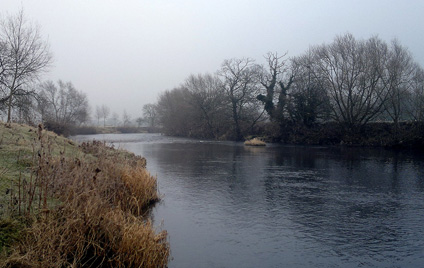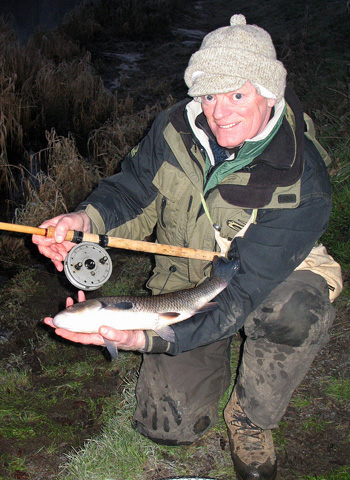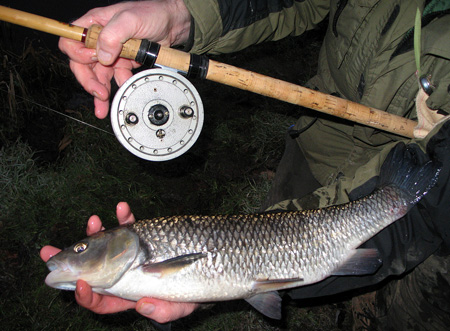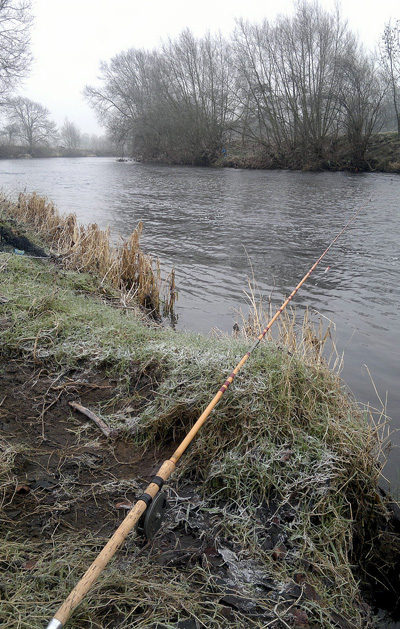My wife eyed the pile of clothes near the door.
“You’re not going fishing in this are you?”
“Why not?”
She looked meaningfully at the lounge window; grey tendrils of freezing fog blurred the outline of the houses across the street and the bare winter stems of the trees glittered with hoar frost. I returned to the kitchen to finish making my flask.
“Doesn’t look too bad.”
An exasperated snort from the lounge.
 In fact when I got there the river didn’t look too bad. It had fined down nicely from the floods of last weekend and a gentle upstream breeze ruffled the surface. That was the good news! The bad news was that the air temperature was -1.5C and, although still running high, the river was like tap water. I’d fancied a bit of chub fishing so I’d put half a sliced loaf in my fishing bag but, given the conditions, I felt that my only realistic chance of catching during the day was going to be to fish for grayling; I left the bread in my bag so that I could fish for chub in the last hour.
In fact when I got there the river didn’t look too bad. It had fined down nicely from the floods of last weekend and a gentle upstream breeze ruffled the surface. That was the good news! The bad news was that the air temperature was -1.5C and, although still running high, the river was like tap water. I’d fancied a bit of chub fishing so I’d put half a sliced loaf in my fishing bag but, given the conditions, I felt that my only realistic chance of catching during the day was going to be to fish for grayling; I left the bread in my bag so that I could fish for chub in the last hour.
Grayling
I exaggerated slightly above; the river wasn’t entirely like tap water as it did have a slight peaty tinge, despite this I could see every stone on the bottom which meant that I was going to have to fish fine and far off. Before tackling up I fed a few maggots into the riffle in front of me; in coloured water I’d have walked a few yards upstream to feed, but today I wanted to catch fish a fair way down the swim. I continued to trickle maggots into the swim whilst I tackled up.
Today I’m using a 50-year-old Milwards Floatcraft rod, matched with a Rapidex centrepin of similar vintage. The rest of my tackle is bang up to date though with a main line of 5lb (.16mm) W B Clarke Match Line and a long hooklength of .11mm Preston Power Line. I’ve been using Guru QM1 hooks for my grayling fishing this season and they seem to be reducing the number of lost fish, but they are a bit big for clear water grayling so I tie on a size 18 wide gape match hook. I’d have preferred to have used a size 20, but I’d forgotten them! My float is a 1 swan Drennan Loafer – a nice short float, ideal for some of the shallow swims I’ll be fishing. I keep my bulk shot small, using four no 4 shot with a no 1 and a BB directly under the float. In deeper water I’ll play around with this shotting, but I know that all the swims I’ll fish today are likely to be less than 2ft 6in deep.
 Before casting I walk down to my next swim and feed a few maggots. I then anoint the rings on the tip section of my rod with glycerine, put a couple of maggots on the hook and make my first cast. I keep the first few trots short and adjust float until the bait is just tripping bottom and I feed three or four maggots every cast trying to build the confidence of the grayling without drawing them too far upstream. Ideally I’m aiming to hook fish about 15 yards downstream. Once I’ve got the depth right I allow the float to travel further down the swim and I hook a medium sized grayling almost immediately.
Before casting I walk down to my next swim and feed a few maggots. I then anoint the rings on the tip section of my rod with glycerine, put a couple of maggots on the hook and make my first cast. I keep the first few trots short and adjust float until the bait is just tripping bottom and I feed three or four maggots every cast trying to build the confidence of the grayling without drawing them too far upstream. Ideally I’m aiming to hook fish about 15 yards downstream. Once I’ve got the depth right I allow the float to travel further down the swim and I hook a medium sized grayling almost immediately.
Over the next ten minutes I land another grayling and lose one, but I then hook a good trout which makes a great commotion before I can net it. I pause for a sandwich and a cup of tea, but despite this rest I hook no more grayling.
I settle into a steady rhythm of move, feed, wait…and then fish, broken only by pauses to clear the rod rings of ice. It’s totally absorbing and I catch quite a few grayling but as the light begins to fade my thoughts turn to chub.
Basic Chubbing
I know just the swim, so I make my way over the frozen meadows to a wide pool that usually produces a chub or two. I approach the swim cautiously, keeping low and taking care not to step too heavily on the frozen ground. When I take the bread from my bag it’s still frozen (I keep a few loaves in my freezer so I’ve always got bread available) so I drop a couple of slices in the margins to thaw and put one slice inside my jacket. By the time I’ve taken off my float, shot and hook length the bread in the margins has thawed. I take each slice, squeeze it, mash it in my hands and feed it well upstream of where I’m going to fish.
I then tie a size 8 hook on to my main line and squeeze three Swan Shot about 18 inches above the hook. I pinch a piece of flake on to the hook, swing it a couple of rod lengths out onto the line I’ve just fed with mash and rest the rod on the marginal reeds – chubbing at its most basic!
Now it’s just a matter of waiting. I feed another slice of mashed bread every quarter of an hour just to keep a steady stream of bread particles drifting down the pool. I miss the first bite as I’m talking to my friend Dave who’s popped down for a chat; I catch the rod top going round out of the corner of my eye, but I’m way too late on the strike.
 Time to concentrate!
Time to concentrate!
Out goes another piece of flake, but this time I hold the rod and touch ledger. After a short wait I feel a quick pluck on the line followed by a steady draw and I lift the rod into a decent chub. The little Floatcraft is a lovely rod to play a chub on, soft enough to enjoy the fight of a decent fish, but with enough backbone to bully it away from snags if needed.
Dave plays the ghillie and slips the net under a nice chub of just under four pounds. We leave the fish in the landing net and I feed another slice of bread, and then recast. This time I get a bite almost immediately, feeling a quick pluck followed by the line going slack and I sweep the rod back and connect with a better fish which nearly makes the snags downstream of me. The rod takes on an alarming curve as it stops the fish in its tracks and it soon joins its mate in my net.
 By now the temperature is dropping sharply and the line feels rough as the water freezes on it. I clear the rod rings of ice, anoint them with some more glycerine and out goes another lump of flake. I don’t need to feel for the next bite as the fish just whacks the rod top round and my ghillie is soon netting another chub. Unfortunately my net is a little on the small side to hold two fish and net a third and one of its occupants makes a bid for freedom. The resulting commotion kills the swim for a while and I lose my ghillie as the cold really starts to bite. I last for a bit longer, catching another three chub all over four pounds, but when I pull out of a chub when a lump of ice jams in my tip ring I decide to call it a day.
By now the temperature is dropping sharply and the line feels rough as the water freezes on it. I clear the rod rings of ice, anoint them with some more glycerine and out goes another lump of flake. I don’t need to feel for the next bite as the fish just whacks the rod top round and my ghillie is soon netting another chub. Unfortunately my net is a little on the small side to hold two fish and net a third and one of its occupants makes a bid for freedom. The resulting commotion kills the swim for a while and I lose my ghillie as the cold really starts to bite. I last for a bit longer, catching another three chub all over four pounds, but when I pull out of a chub when a lump of ice jams in my tip ring I decide to call it a day.
It’s now full dark, but the frozen pastureland glistens in what little moonlight penetrates the murk and lights my way back to the car. It’s been a good day.
 Single Rod Fishing
Single Rod Fishing
Today has been fishing at its most basic and, in my opinion, its best. I’m not by nature a sit in one place angler and I like to be mobile when fishing. The only tackle that I took with me was a few floats, some packets of hooks, some hooklength line and a box of split shot. These fit comfortably in my jacket pocket, but I also took a small bag with some food, a warm drink and half a sliced loaf.
I find a 13 foot float rod a little unwieldy for ledgering so I compromise and use a shorter rod. For me this tends to be a cane rod around 10ft 6in or 11ft long, but those of you who aren’t cane heads will find that one of the shorter float rods designed for commercials will work really well. In fact I’ve found that these shorter rods work almost as well as longer rods for float fishing and it’s rare that I find a swim that I struggle to fish. This is highly mobile fishing so I don’t take a rod rest or even a chair. At a pinch I can lay the rod in the bank-side vegetation, but normally I’ll hold it even when ledgering. This keeps me mobile as I’m not tempted to sit it out in one swim waiting for a bite.
I think we tend to over complicate our fishing. You’ve only got to read through the forums to find debates on how to loose feed for grayling or what flavours to use for chub. Fishing like this forces you to go back to basics and concentrate on what really matters: presenting a bait in as simple and natural a manner as possible.
Why don’t you give it a try?










